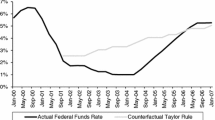Abstract
This article discusses the immediate and the longer-term future of monetary policy. It first reviews the policies adopted by central banks in the wake of the financial crisis, focusing on balance sheet policies and forward guidance, and then discusses the exit from these policies and the associated challenges. Finally, an outlook on the possible long-term design of monetary policy is provided.




Similar content being viewed by others
Notes
The major exception being the swap agreements with foreign central banks, most notably the ECB. However, these operations addressed U.S. dollar requirements of non-U.S. banks.
Under the CBPP I, a nominal amount of EUR 60 billion was bought; the maximum amount of EUR 40 billion of the CBPP II was not fully utilized. At the end of March 2014, holdings of MBS and agency debt by the Federal Reserve stood at USD 1,650 billion, and they are still rising further.
Including the Bank of England and the Bank of Japan would not yield much different evidence.
In June 2013, FOMC Chairman Bernanke expected that the Fed would continue to reduce the pace of asset purchases in measured steps through the first half of 2014, ending purchases around midyear 2014.
For a thorough discussion, see Committee on the Global Financial System (2011).
References
Bean, C., Paustian, M., Penalver, A. and Taylor, T. (2010). Monetary policy after the fall. Paper presented at the federal reserve bank of Kansas City annual economic policy symposium. Jackson Hole.
Blanchard, O., Dell’Ariccia, G., and Mauro, P. (2010). Rethinking macroeconomic policy. IMF Staff Position Note, SPN/10/03, International Monetary Fund.
Blanchard, O., Dell’Ariccia, G. and Mauro, P. (2013). Rethinking macroeconomic policy II: Getting granular. IMF Staff discussion Note, SDN/13/03, International monetary fund.
Borio, C. (2011). Central banking post-crisis: What compass for unchartered waters? Keynote address at the SUERF-National Bank of Poland Conference “Monetary policy after the crisis.” Warsaw. Vol. 4.
Clarida, Richard. 2010. What has—and has not—been learned about monetary policy in a low inflation environment? A review of the 2000s. http://citeseerx.ist.psu.edu/viewdoc/download?doi=10.1.1.372.9790&rep=rep1&type=pdf (retrieved on April 16, 2014).
Committee on the global financial system. (2011). Global liquidity – concept, measurement and policy implications. CGFS Papers No. 45. Bank for International Settlements.
ECB. (2013). Banking structures report. Frankfurt: European Central Bank.
Fahr, S., Motto, R., Rostagno, M., Smets, F., and Tristani, O. (2010). A monetary policy strategy in good and bad times: Lessons from the recent past. Presentation at the sixth ECB Central Banking Conference. Frankfurt.
Gerlach, S. (2013). Monetary policy after the crisis. The Manchester School, 81, 16–34.
Issing, O. (2011). Lessons for monetary policy: what should the consensus be? IMF working paper WP/11/97. International monetary fund. Washington D.C.
Krishnamurthy, A. (2013). The Ins and outs of large scale asset purchases. Presentation given at the federal reserve bank of Kansas City annual economic policy symposium. Jackson Hole.
Mishkin, F.S. (2011). Monetary policy strategy: lessons from the crisis. NBER working paper 16755. National Bureau of Economic Research.
Acknowledgments
Special thanks to Clemens Jobst, Claudia Kwapil und Paul Pichler (all Austrian National Bank (OeNB)) for valuable discussions and contributions.
Author information
Authors and Affiliations
Corresponding author
Rights and permissions
About this article
Cite this article
Nowotny, E. The Future of European Monetary Integration. Atl Econ J 42, 229–242 (2014). https://doi.org/10.1007/s11293-014-9420-8
Published:
Issue Date:
DOI: https://doi.org/10.1007/s11293-014-9420-8




